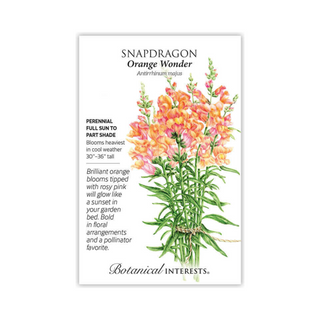
Description
Long-blooming in gardens and long-lasting in bouquets, 'Orange Wonder' wows with its blazing display of peachy orange blossoms brimmed with pink, framed by lush green foliage. The uniquely-shaped, vibrant blooms are also edible and make a whimsical garnish on salads, desserts, and beverages. Adorn beds and borders to keep your garden abuzz with pollinators all season long! Perennial in USDA zones 5 and warmer, usually grown as an annual.
Variety Info
- Family: Plantaginaceae (formerly Scrophulariaceae) Plantain family, includes statice, armeria, plumbago, snapdragon, penstemon, veronica, and toadflax.
- Native: Southern Europe, Northern Africa, and West Asia
- Hardiness: Usually grown as an annual, though perennial in USDA zone 5 and warmer.
- Exposure: Full sun to part shade
- Bloom Period: Heaviest in cool weather
- Plant Dimensions: 30"–36" tall, 10"–12" wide
- Variety Info: 1 ½" flowers in an ombre shade of bright orange that blends into a deep pink.
- Attributes: Attracts Pollinators, Cut Flower, Edible Flower
Sowing Info
- When to Sow Outside: Cold Climates: 4 to 6 weeks before your average last frost date, or as soon as soil can be worked. Mild Climates: Late summer to early fall for winter and spring bloom.
- When to Start Inside: RECOMMENDED. 8 to 10 weeks before your average last frost date.
- Days to Emerge: 10 – 15 days
- Seed Depth: Surface
- Seed Spacing: A group of 3 seeds every 12"
- Thinning: When 1/2" tall, thin to 1 every 12"
Growing Info
- Harvesting: For longest vase life, harvest in the morning, choosing stems that have about half of the bottom flowers open. Change vase water frequently.
- Special Care: Once flowers have over 4 sets of leaves, trim plants (pinching) to just above the 3rd set of leaves to encourage branching. Although you won't have blooms for a couple of weeks, when you do, the plants will be bushier with a lot more flowers. Cutting back spent flower stalks will encourage fall blooming after primary late spring/early summer bloom. Snapdragons reseed, so cut off spent blooms if reseeding is not desirable. Since snapdragons are susceptible to rust, a foliage disease, avoid wetting the leaves when watering.
Description
Long-blooming in gardens and long-lasting in bouquets, 'Orange Wonder' wows with its blazing display of peachy orange blossoms brimmed with pink, framed by lush green foliage. The uniquely-shaped, vibrant blooms are also edible and make a whimsical garnish on salads, desserts, and beverages. Adorn beds and borders to keep your garden abuzz with pollinators all season long! Perennial in USDA zones 5 and warmer, usually grown as an annual.
Variety Info
- Family: Plantaginaceae (formerly Scrophulariaceae) Plantain family, includes statice, armeria, plumbago, snapdragon, penstemon, veronica, and toadflax.
- Native: Southern Europe, Northern Africa, and West Asia
- Hardiness: Usually grown as an annual, though perennial in USDA zone 5 and warmer.
- Exposure: Full sun to part shade
- Bloom Period: Heaviest in cool weather
- Plant Dimensions: 30"–36" tall, 10"–12" wide
- Variety Info: 1 ½" flowers in an ombre shade of bright orange that blends into a deep pink.
- Attributes: Attracts Pollinators, Cut Flower, Edible Flower
Sowing Info
- When to Sow Outside: Cold Climates: 4 to 6 weeks before your average last frost date, or as soon as soil can be worked. Mild Climates: Late summer to early fall for winter and spring bloom.
- When to Start Inside: RECOMMENDED. 8 to 10 weeks before your average last frost date.
- Days to Emerge: 10 – 15 days
- Seed Depth: Surface
- Seed Spacing: A group of 3 seeds every 12"
- Thinning: When 1/2" tall, thin to 1 every 12"
Growing Info
- Harvesting: For longest vase life, harvest in the morning, choosing stems that have about half of the bottom flowers open. Change vase water frequently.
- Special Care: Once flowers have over 4 sets of leaves, trim plants (pinching) to just above the 3rd set of leaves to encourage branching. Although you won't have blooms for a couple of weeks, when you do, the plants will be bushier with a lot more flowers. Cutting back spent flower stalks will encourage fall blooming after primary late spring/early summer bloom. Snapdragons reseed, so cut off spent blooms if reseeding is not desirable. Since snapdragons are susceptible to rust, a foliage disease, avoid wetting the leaves when watering.

